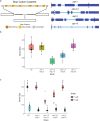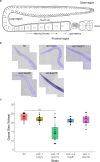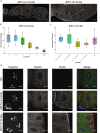Zinc transporters ZIPT-2.4 and ZIPT-15 are required for normal C. elegans fecundity
- PMID: 35501415
- PMCID: PMC9174417
- DOI: 10.1007/s10815-022-02495-z
Zinc transporters ZIPT-2.4 and ZIPT-15 are required for normal C. elegans fecundity
Abstract
Purpose: The requirement of zinc for the development and maturation of germ lines and reproductive systems is deeply conserved across evolution. The nematode Caenorhabditis elegans offers a tractable platform to study the complex system of distributing zinc to the germ line. We investigated several zinc importers to investigate how zinc transporters play a role in the reproductive system in nematodes, as well as establish a platform to study zinc transporter biology in germline and reproductive development.
Methods: Previous high throughput transcriptional datasets as well as phylogenetic analysis identified several putative zinc transporters that have a function in reproduction in worms. Phenotypic analysis of CRISPR-generated knockouts and tags included characterization of offspring output, gonad development, and protein localization. Light and immunofluorescence microscopy allowed for visualization of physiological and molecular effects of zinc transporter mutations.
Results: Disruption of two zinc transporters, ZIPT-2.4 and ZIPT-15, was shown to lead to defects in reproductive output. A mutation in zipt-2.4 has subtle effects on reproduction, while a mutation in zipt-15 has a clear impact on gonad and germline development that translates into a more pronounced defect in fecundity. Both transporters have germline expression, as well as additional expression in other cell types.
Conclusions: Two ZIP-family zinc transporter orthologs of human ZIP6/10 and ZIP1/2/3 proteins are important for full reproductive fecundity and participate in development of the gonad. Notably, these zinc transporters are present in gut and reproductive tissues in addition to the germ line, consistent with a complex zinc trafficking network important for reproductive success.
Keywords: Caenorhabditis elegans; Fecundity; Germline development; Germline gene expression; Zinc transporter.
© 2022. The Author(s), under exclusive licence to Springer Science+Business Media, LLC, part of Springer Nature.
Conflict of interest statement
The authors declare no competing interests.
Figures





Similar articles
-
Zinc transporters maintain longevity by influencing insulin/IGF-1 activity in Caenorhabditis elegans.FEBS Lett. 2020 May;594(9):1424-1432. doi: 10.1002/1873-3468.13725. Epub 2020 Jan 15. FEBS Lett. 2020. PMID: 31883120
-
The zinc transporter ZIPT-7.1 regulates sperm activation in nematodes.PLoS Biol. 2018 Jun 7;16(6):e2005069. doi: 10.1371/journal.pbio.2005069. eCollection 2018 Jun. PLoS Biol. 2018. PMID: 29879108 Free PMC article.
-
A pathway for low zinc homeostasis that is conserved in animals and acts in parallel to the pathway for high zinc homeostasis.Nucleic Acids Res. 2017 Nov 16;45(20):11658-11672. doi: 10.1093/nar/gkx762. Nucleic Acids Res. 2017. PMID: 28977437 Free PMC article.
-
Insulin and germline proliferation in Caenorhabditis elegans.Vitam Horm. 2011;87:61-77. doi: 10.1016/B978-0-12-386015-6.00024-X. Vitam Horm. 2011. PMID: 22127237 Free PMC article. Review.
-
Germ granules and gene regulation in the Caenorhabditis elegans germline.Genetics. 2022 Mar 3;220(3):iyab195. doi: 10.1093/genetics/iyab195. Genetics. 2022. PMID: 35239965 Free PMC article. Review.
Cited by
-
Lysosome-related organelles contain an expansion compartment that mediates delivery of zinc transporters to promote homeostasis.Proc Natl Acad Sci U S A. 2024 Feb 13;121(7):e2307143121. doi: 10.1073/pnas.2307143121. Epub 2024 Feb 8. Proc Natl Acad Sci U S A. 2024. PMID: 38330011 Free PMC article.
References
-
- Lin YJ, et al. Detrimental effect of maternal and post-weaning high-fat diet on the reproductive function in the adult female offspring rat: roles of insulin-like growth factor 2 and the ovarian circadian clock. J Assist Reprod Genet. 2017;34:817–826. doi: 10.1007/s10815-017-0915-5. - DOI - PMC - PubMed
MeSH terms
Substances
Grants and funding
LinkOut - more resources
Full Text Sources

